Managed Realignment as a coastal management tool
- 28 April 2021
- Wietse van de Lageweg & Francien Horrevorts
Managed realignment as a tool for sustainable coastal management. Wietse van de Lageweg explained what this is during his talk on the latest Polder2C’s partner meeting. Interested to learn more? Read the summary or watch the full presentation.
Wietse van de Lageweg
Dr. Wietse van de Lageweg is Lecturer Coastal Systems at HZ University of Applied Sciences. He is a member of the Building with Nature Research Group, studying Sustainable delta Management, Climate-proof Coastlines and Environmental-friendly Infrastructures. Wietse explains about Managed Realignment, using examples of previous projects and he introduces a Serious Game to better understand the societal aspects of coastal landscape transitions.
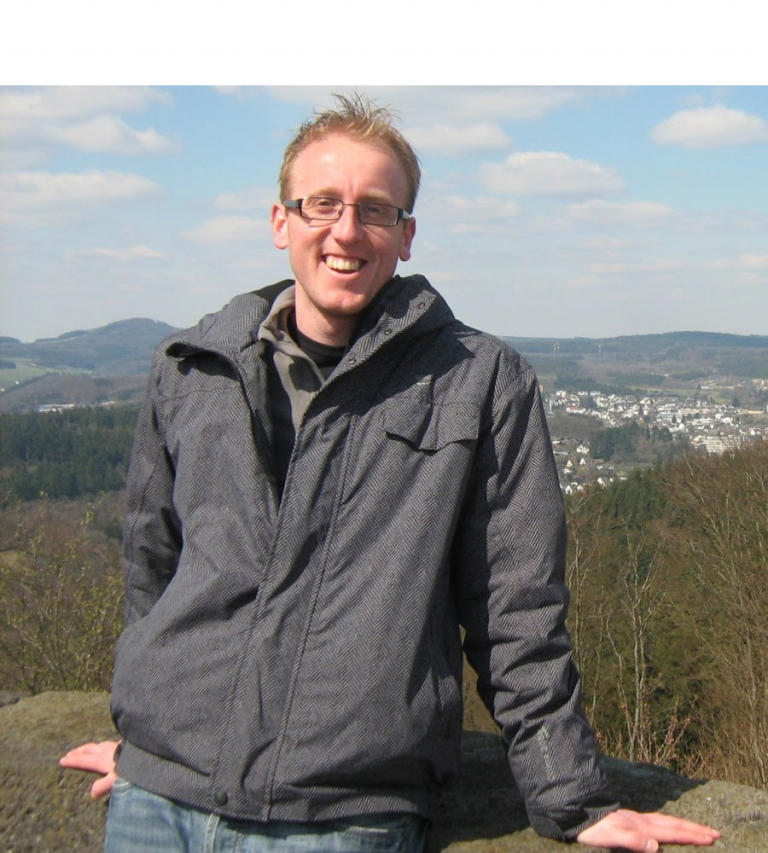
Managed Realignment
The depoldering of the Hedwige-Prosperpolder, which gave the opportunity to develop a Living Lab in the area, is a so-called managed realignment project. Managed realignment is an ecosystem engineering coastal management approach motivated by concerns about ecological functioning and sea-level rise. It involves relocating the line of defense landward, mimicking what would normally happen with marine environments during a period of sea-level rise.
Pros of Management Realignment
Good reasons to choose for managed realignment are:
- It is motivated by ecological functioning as well as climate adaptation. It is a response to the poor ecological status of many estuaries globally. In the case of the Hedwige-Prosperpolder it primarily serves as a nature compensation measure for the expansion of the Antwerp harbour.
- It allows for the formation of new tidal flats and salt marshes. It acts as a host of ecosystem services, for example as a nursery, for rare habitats and unique species.
- Perceived benefits are lower costs compared to upgrading of the primary defense and it is a stimulus for recreation.
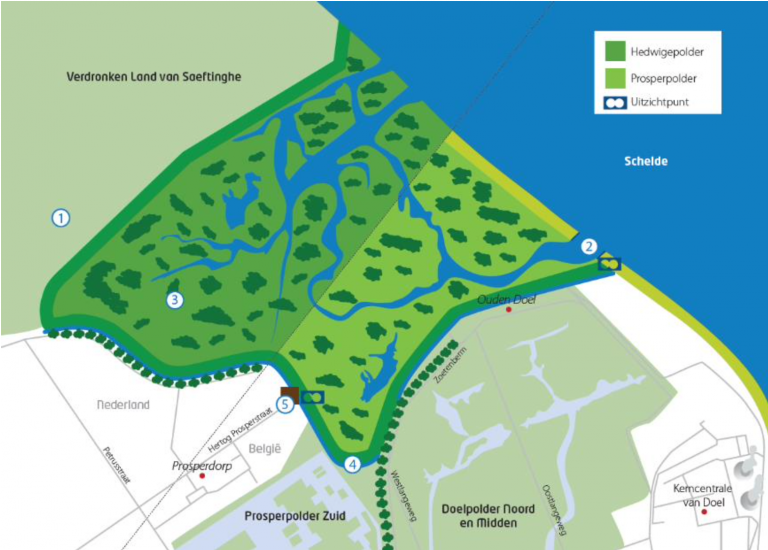
Coastal management approach
Many factors play a role in managed realignment as a coastal management approach, such as the site history and planning, geophysics and chemical, ecological and socio-economic factors. Current projects are primarily motivated by nature compensation. It has important benefits for water safety and ecological functioning at estuary scale. The Hedwige-Prosperpolder serves as a water reservoir during flood: it reduces high water. Also, it creates an additional intertidal area in the Scheldt estuary and it creates unique rare habitats for ecology.
Monitoring results
Two managed realignment sites in the Netherlands where interdisciplinary monitoring frameworks have been set up to record physical and ecological processes give some more understanding; the Rammegors and Perkpolder areas. Aim of the monitoring was to increase our understanding of the (a)biotic factors controlling the short term (0-4 years) evolution of the areas following tidal recovery. From 2015 until 2018, the tidal restoration in Rammegors has been followed by monitoring elevation, sediment, groundwater and vegetation. In addition, benthic communities were monitored. During the same period monitoring was set up in the Perkpolder for morphology, groundwater, vegetation and benthic communities.
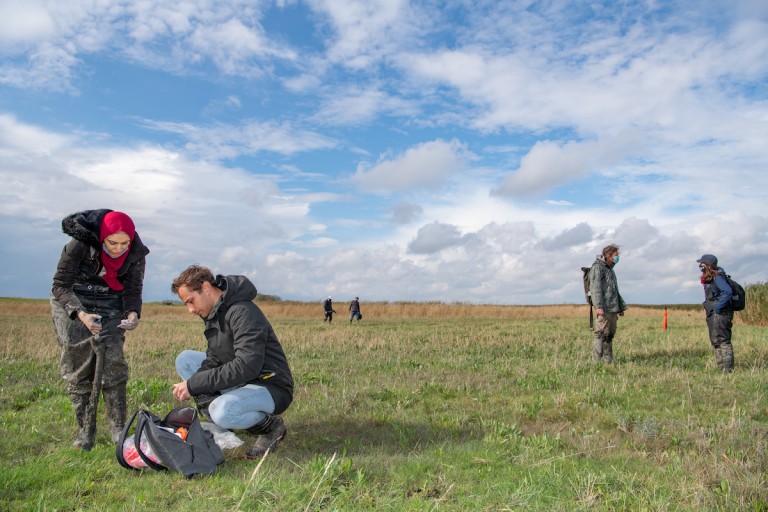
Photo: HZ University Of Applied Sciences Audiovisual Team
Rammegors
In 1972 the Rammegors was disconnected from the Eastern Scheldt. In the following years low dynamics and a decrease of biodiversity were noted. In 2016 the Rammegors was re connected to the Eastern Scheldt as a nature compensation measure and because of an imbalance between the hydrodynamics and morphology of the Eastern Scheldt. Also, new intertidal areas are a measure to counteract the ongoing loss.
Lessons learned from Rammegors
For monitoring the Rammegors tidal restoration a great variety of techniques was required: field surveys, lab-analyses, statistical analyses and numerical simulations. The conclusions relating to tidal recovery:
- Limited morphological changes: Eastern Scheldt is a sediment-poor system
- Strong salinization within Rammegors, but the effects on surrounding are limited
- Transition from freshwater vegetation to saline-tolerant vegetation
- Fast colonisation by benthic macrofauna
- Spatial trends: increase in species diversity, density and biomass with distance to the inlet and fining of sediment
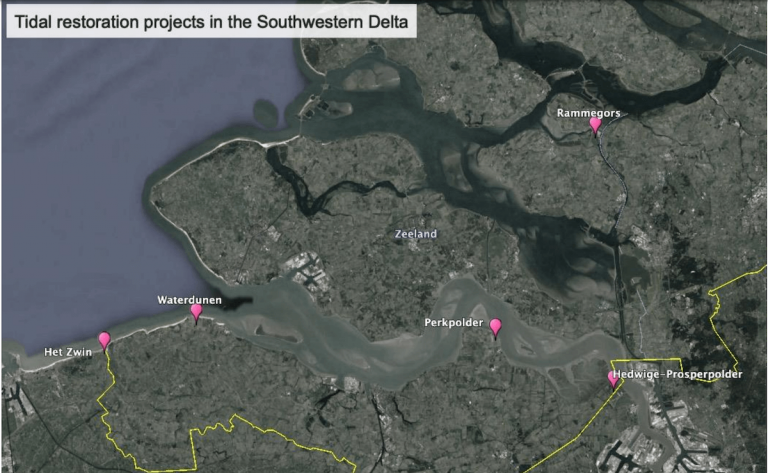
Perkpolder
Perkpolder is located in the Western Scheldt. The motivation for this project was nature compensation as part of the extension of the waterway to Antwerp harbour. Monitoring has provided important insights into morphological and ecological development following tidal restoration regarding the design of the inlet, the dimensions of the man-made tidal creeks and the topography of the tidal flats. And unique knowledge is obtained on the effectiveness of a seepage installation.
Future monitoring
The monitoring will be continued to better understand the medium term (4-10 years) effects of tidal restoration on abiotic and biotic factors. This future monitoring will also focus on socio-economic aspects and it is valuable Input for future restoration projects and adaptive coastal management. In the end lessons are derived and transferred to the coastal landscape transition that is currently taking place in the Hedwige-Prosperpolder area.
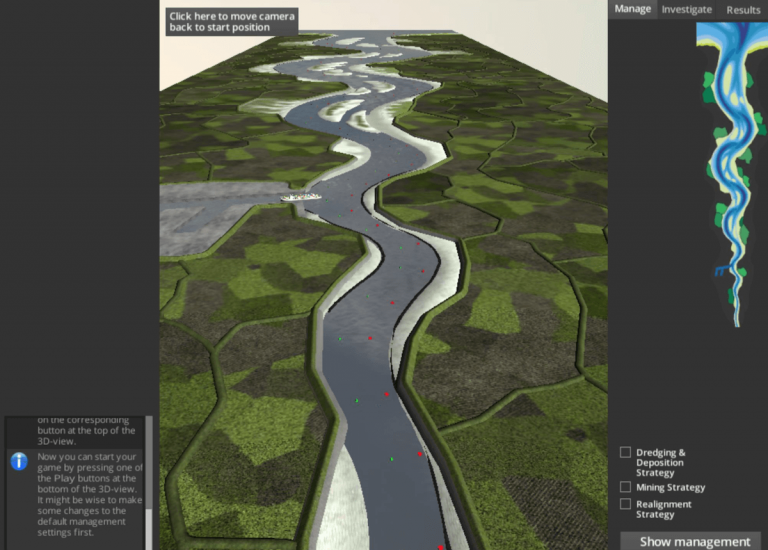
Screen shot of Serious Game Managing the Scheldt estuary. The Serious Game was originally developed by Houtekamer & Van Kleef in partnership with NIOZ as part of the Interreg North Sea EMOVE project and is publicly available on this website.
Serious Game
Besides explaining about monitoring morphological and ecological data, Wietse introduces a fun element, related to the social aspects of these kinds of projects; Serious Game. Broad societal support is a prerequisite for implementation of coastal interventions for coastal climate change adaptation. Serious Games can help obtain a better understanding of each other's perspectives and needs. This game is used to get insight into the social processes involved in managed realignment projects. The Polder2C’s partners are introduced to the serious game Managing the Western Scheldt, which was originally developed by Houtekamer & Van Kleef in partnership with NIOZ as part of the Interreg North Sea EMOVE project. It allows to experience the complexity of estuarine management and learn about estuarine processes and is a fun way to learn and get involved.
Watch full presentation
For more detailed information and the full presentation of Wietse van de Lageweg, watch the video.
HZ University of Applied Sciences and Polder2C’s
HZ University of Applied Sciences is one of the thirteen project partners of Polder2C’s. Their contribution to the Polder2C’s project is distributed to the following activities. They participate in activities and research related to the overflow, overtopping and wave impact tests in the Living Lab. They are responsible for a risk perception study that will illustrate commonalities and differences between Flemish and Dutch citizens in the surroundings of the Hedwige-Prosperpolder, and they are responsible for the organisation of the Winter Schools oversight of all educational activities of Polder2C’s.
Read more
Did you like this article? You may also like to read the interview with Vana Tsimopoulou from HZ University of Applied Sciences.
